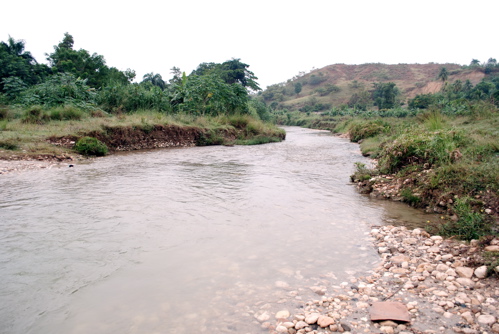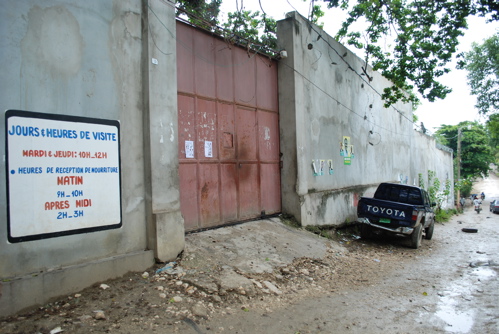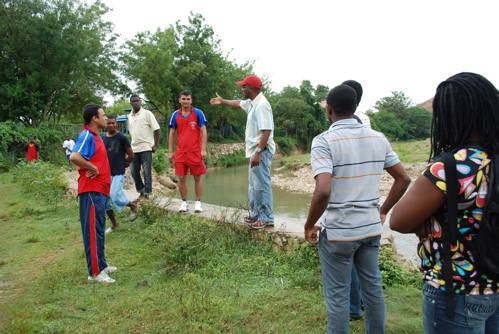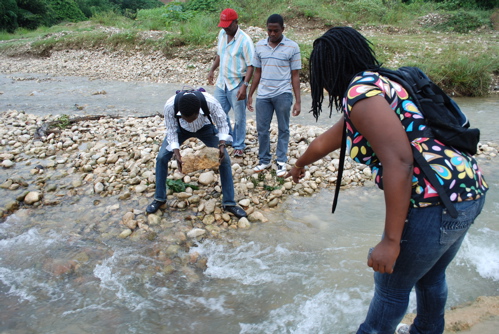 In very worrisome news Tuesday, the Haitian Health Ministry estimated that the cholera outbreak in Haiti is resulting in an average of 32 deaths every 24 hours since the epidemic began on October 20. The Ministère de la Sante Publique et de la Population de Haïti (MSPP) reported 73 hospitalized cases due to cholera in Port-au-Prince in the neighborhoods of Carrefour, Cite Soleil, Delmas, Kenscoff, Petion Ville, Port-au-Prince, and Tabarre. Out of 9,123 cases, 583 have died. That is a death rate of 1 death for every 16 people infected. Put another way, the death rate is 6 percent. World Health Organization figures for 2008 are total of 190, 130 cases from 56 countries, including 5143 deaths, or one death per 36 infections, or 3 percent. Why is the death rate for Haiti so much higher when the epidemic is just beginning?
In very worrisome news Tuesday, the Haitian Health Ministry estimated that the cholera outbreak in Haiti is resulting in an average of 32 deaths every 24 hours since the epidemic began on October 20. The Ministère de la Sante Publique et de la Population de Haïti (MSPP) reported 73 hospitalized cases due to cholera in Port-au-Prince in the neighborhoods of Carrefour, Cite Soleil, Delmas, Kenscoff, Petion Ville, Port-au-Prince, and Tabarre. Out of 9,123 cases, 583 have died. That is a death rate of 1 death for every 16 people infected. Put another way, the death rate is 6 percent. World Health Organization figures for 2008 are total of 190, 130 cases from 56 countries, including 5143 deaths, or one death per 36 infections, or 3 percent. Why is the death rate for Haiti so much higher when the epidemic is just beginning?
That is the math. When we arrived in Haiti on Saturday, Hurricane Tomas had come and gone, injuring 36 people: leaving 11 missing and 20 dead, according to the latest estimates by Haitian authorities. But Tomas left another legacy in the valleys below the central plateau. The Artibonite River overflowed its banks, flooding rice and cornfields; spreading the cholera bacterium like dandelion seeds in the wind. You can follow the timeline at the Pan American Health Organization website on an interactive map.
It has been speculated by Haitians and others that the source of the cholera outbreak in Haiti is the Nepalese Annapurna United Nations camp near Mirebalais. The World Health Organization has said that it is not important that we worry about the source of the cholera.

Meye River Looking Downstream From Annapurna Camp
The Haitian people feel differently.
Immediately after we deplaned in Port-Au-Prince, we met with Lavarice Gaudin, a well-known leader of the Haitian Diaspora. Gaudin urged us to travel to Mirebalais to meet with locals and investigate how the Nepalese were allegedly engaged in a cover-up of the faulty septic system that introduced cholera into the Meye River, one of the tributaries of the Artibonite River. The Artibonite flows through fertile farmlands and Gaudin insisted that Haitians need reparation for lives lost and crops that are now tainted.
“You cannot put a monetary value on a human life,” Gaudin said, “but how can farmers cope with the added tragedy of ruined crops of rice, corn, vegetables and beans?”
Gaudin offered the observation that the “UN has done nothing for Haiti. They have not provided electricity, hospitals, schools or clean water,” he said. “The UN has spent up to $50.6 million per month in Haiti. For what?”
We checked those figures, and they turned out be a conservative estimate. The UN mission in Haiti (MINUSTAH) had nearly $60 million approved for July 2009 to June 2010. This included “an increase in the Mission’s troop and police levels — to 8,940 and 3,711, respectively — to support immediate recovery, reconstruction and stability efforts.”
So, we went to Mirebalais to see the UN Annapurna base for ourselves, and through the assistance of Gaudin and the Haitian Lawyers Leadership Network (HLLN), we were able to contact leaders in the Mirebalais community. It is important that Haitians provide testimony that is not filtered through the eyes of the international donor community, the politically correct pronunciations of the Centers for Disease Control, WHO, NGOs, and the Haitian government. Cholera is new to Haiti and tests on this strain showed that it had to originate in either South or South East Asia. The UN is in full denial mode that the Annapurna base was ground zero.
The Nepalese troops were not tested for cholera before their deployment if they did not present symptoms. But health officials say 75 percent of people infected with cholera bacteria do not show symptoms and can still pass on the disease for weeks.
Feeder bands from Tomas left a fine mist of rain and fog as we navigated the mountain and valley roads. The streets of Mirebalais were wet and muddy, and mud squished over our shoes as we gingerly stepped out of our jeep to talk to the local police — the PNH. Once again, the conversation was very critical regarding the Nepalese UN soldiers.
“They change guard every three hours and stand at the gate, doing nothing. When we go on a mission with them, we cannot count on them. Communication is a big problem. They don’t speak Creole or French. They can’t communicate with us and they can’t communicate with the people.”
We had previously learned that there were 100 confirmed cases of cholera and five deaths at the local jail early in the epidemic. Could the PNH officer direct us to the jail? He pointed at the building behind us. We were standing in front of the gate. Suddenly the mud soaking up our pants’ legs became an issue.

The Jail in Mirebalais
One phone call and one container of hand sanitizer later, three members of the Collectif des Etudiants Mirebalais (CEH) joined us. The plan was to take us to the source of the contagion—outlet pipes from the drain field at the Anapurna camp that emptied directly into the Meye River. The students told us that shortly after the Center for Disease Control tests indicated the south Asia connection, the Nepalese reconfigured the drain field and put razor wire around the openings. This was definitely something we should document.
The students gave us permission to use photos of them, but since they were involved in organizing a demonstration on October 29, they did not want their names made public.
The Nepalese Annapurna camp is a short distance from the center of Mirebalais. The walls of the compound form a perimeter that does not include the river, and it would be quite easy to simply walk on Haitian soil to the drain field outlet. So, assured we were not on UN grounds, we began to walk, but the students held back. At first we did not understand why, but it soon became obvious. Suddenly, there was loud shouting and waving coming from the guard turrets. It was obvious the guards within the compound did not want us walking there. Rather than press the issue, we thought it would show good faith to simply make our way around to the front gate, explain that I was an American journalist, we were on Haitian soil, and wanted to walk to riverbank to examine the alleged source of the cholera.
Readers can guess what happened next. After a pleasant conversation inside the compound with a Nepalese in civilian clothes, using a combination of French, English, Creole and Nepali, it was obvious that it did not make any difference whether we were Haitian, American, or from Andromeda — there would be no access unless we wanted to cross the rain-swollen, cholera contaminated river and view the source from a very long distance away. Our translator made an impassioned argument that the United Nations could not keep Haitians from walking on Haitian soil, but it made no impact.
We regrouped and figured we should just proceed, since there was nothing the Nepalese soldiers could do legally to stop us. We were wrong. I offered to go first, relying on the almighty American passport. Nepalese soldiers in civilian clothes repeatedly blocked our path, and I repeatedly and politely stepped around them. This went of for several minutes as the shouting grew louder and louder from the turrets culminating in agitated conversations on hand-held radios. At that point, I reconsidered, figuring the UN soldiers could not arrest me, but a sympathetic local police might consider doing just that. There was no way to know for sure, so I backed off.

Nepalese UN Soldiers (out of uniform) Blocking the Way
My Haitian translator once again argued vehemently, demanded to know what right the Nepalese soldiers had to keep us off Haitian soil that was clearly not within their perimeter.

The students wanted to try crossing the river, but it was too deep for the Jeep and even though they students were piling stones for us to use as a bridge, the thought of what was in the water told me to say “no.”
The first question that arises is why would the Nepalese refuse access on public property if they had nothing to hide? We asked for the test results they conducted with an independent lab in the Dominican Republic. The answer was “no,” but the Nepalese man we originally spoke with said the “tests were negative.”
Why hide a negative result?
The tests were allegedly conducted on an underground waste container and this has been reported by Jonathan Katz of the Associated Press, but not analyzed in mainstream media.
No one knows brand and type of method used to test the Nepalese septic tanks. There is a huge variation in the sensitivity of various tests. Was it one of many available rapid tests or a routine old-fashioned culture method? Rapid tests consistently detect cholera at between 2000 colony forming units (CFU) per milliliter (ml) to up to 20,000,000 CFU per ml (least sensitive test). A CFU means one live bacterium capable of reproduction.
In order to become ill from cholera, one needs to ingest between 1000 and 1,000,000 organisms (100-10,000 if ingested with food). Therefore, if one drinks one cup (500 ml) of contaminated water, along with food, that cup of water only needs 2 bacteria per ml to cause infection.
That is .0000001 the concentration needed to be consistently detected by the least accurate rapid test. This is the worst-case scenario. More likely, one might ingest just 5 ml (one teaspoon) of contaminated water containing 200,000 CFU /ml, which is guaranteed to cause infection. Even this concentration is only 1 percent of the concentration needed to be consistently detected by the least sensitive rapid test.
The bottom line is that even if the most advanced rapid testing was done in the world’s best laboratory, the negative results are meaningless. If a genetic PCR test was used, results might be more reliable.
The UN could clear thus up by releasing information regarding their testing. However, one would suspect that an independent lab in the Dominican Republic would not have the capability of doing PCR testing.
For the World Health organization to ignore this gap in information and say that it is not important to know where the epidemic began is political maneuvering, especially since the Haitian government and the CDC will need the cooperation of the UN to help contain this outbreak, if it can be contained.
Cholera is excreted in the feces and vomit. The contagion can be found in feces for up to 50 days, on glass for up to a month, on coins for a week, in soil or dust for up to 16 days, and on fingertips for 1 to 2 hours
That is the bad news.
The good news is that the local television station in Mirebalais had footage of the October 29 demonstration that includes visuals of the reconfigured septic outlet. The footage is jerky, but you can clearly see clean stones, fresh razor wire, and an unidentifiable bluish-green muck in the river.
I added the title frames and took clips from a 45 minute file. WATCH THE VIDEO HERE-
In this case, a few frames of video are worth more than the thousands of words offered in this article.
All images taken by G. Nienaber. Please use in the interest of the Haitian People.